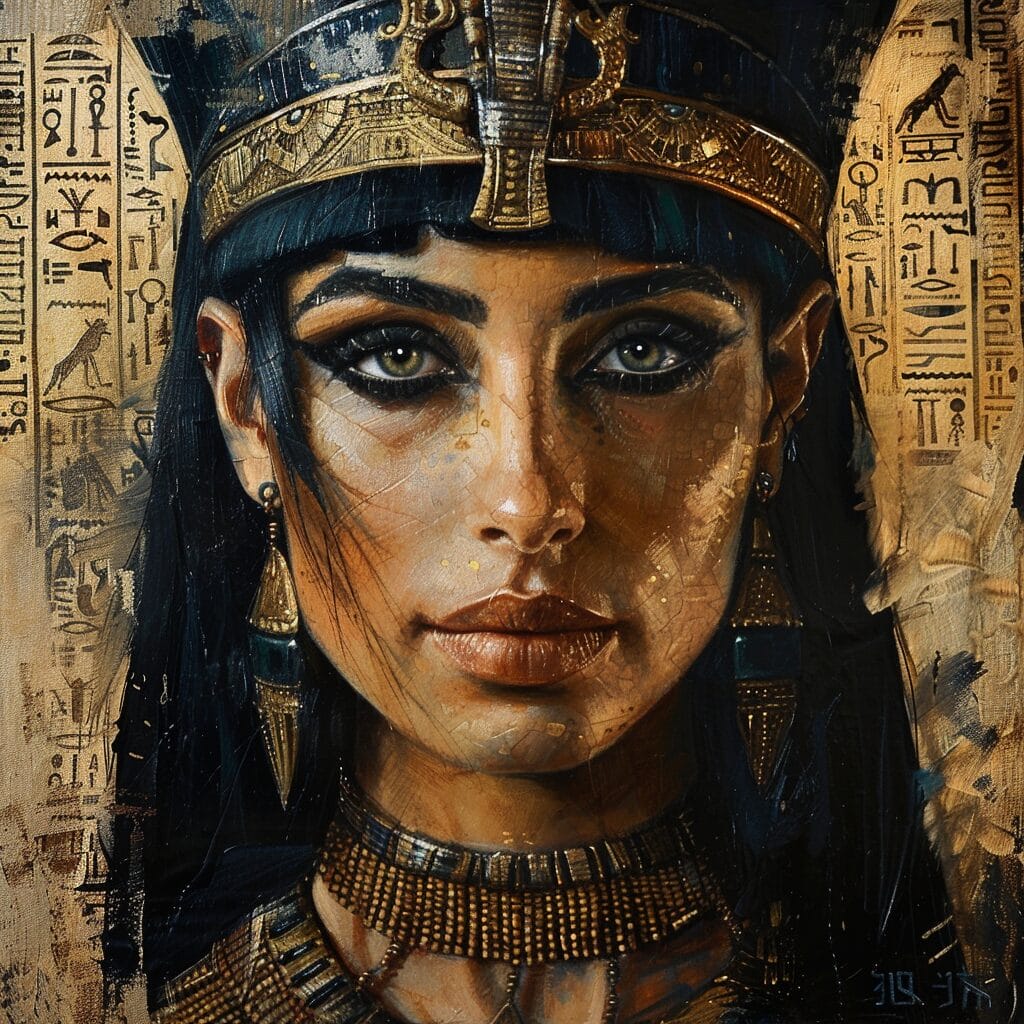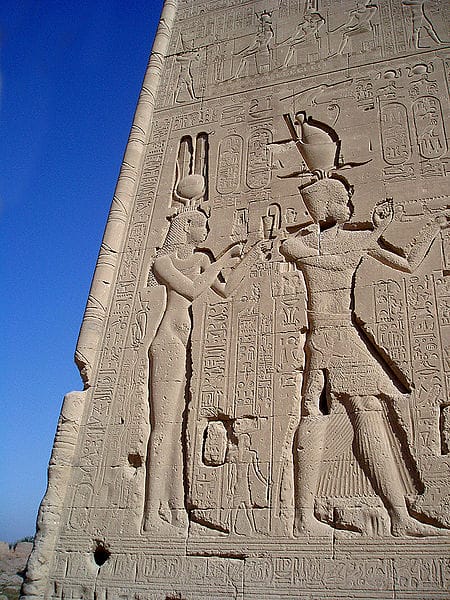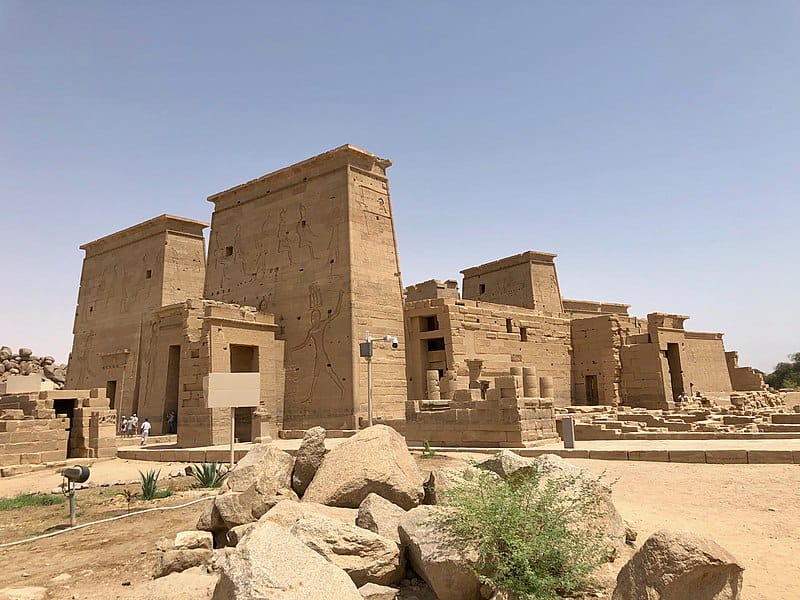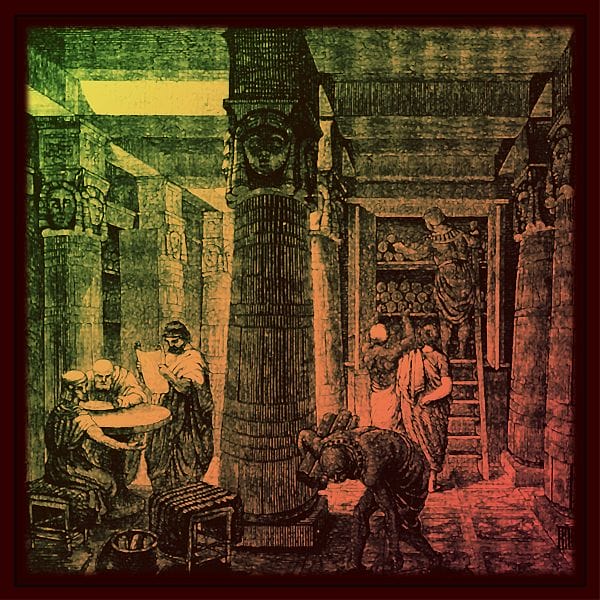Cleopatra VII, the last pharaoh of Egypt, remains one of history’s most intriguing figures. Born into the Ptolemaic dynasty that had ruled Egypt for centuries, she ascended to the throne and became emblematic of her country’s legacy and influence.
Under her reign, she revitalized Egypt’s political and economic standing, etching her name into the annals of history not just as a leader but as a shaper of cultural and diplomatic ties that would resonate far beyond her lifetime.
Key Takeaways
- Cleopatra was the final monarch of the Ptolemaic dynasty and sought to revitalize Egypt’s standing.
- She fostered critical alliances and diplomatic ties, notably with Roman leaders Julius Caesar and Mark Antony.
- Although her reign concluded with the Ptolemaic dynasty, Cleopatra’s impact as a powerful ruler endures in history.
Early Life and Ascension to Power
Cleopatra VII, born into a legacy of pharaonic power, would emerge from the shadows of Alexandria’s royal palace to ascend the throne of the Ptolemaic Kingdom. Her early years set the stage for a reign that would be as turbulent as it was historic.
Birth and Family Lineage
She was the daughter of Ptolemy XII Auletes, a ruler of the Macedonian dynasty that had governed Egypt for nearly three centuries. Born in 69 BC in Alexandria, the heart of Hellenistic culture, her birth elevated her into a lineage of rulers descended from Ptolemy I Soter, a general under Alexander the Great and the founder of the Ptolemaic Dynasty.

Rise to the Throne
Following the death of her father in 51 BC, Cleopatra ascended to the throne as co-ruler with her younger brother, Ptolemy XIII, according to the custom of the Ptolemaic Kingdom that often saw siblings marrying and ruling together. The political landscape she inherited was fraught with challenges, including economic difficulties and a destabilized royal court.
Despite her youth, her strategic acumen soon became apparent as she navigated the complex dynamics of power in Alexandria. Her eventual sole rule would be marked by alliances and rivalries that shaped the fate of her dynasty and the broader Mediterranean world.
Cleopatra’s Reign and Political Alliances
Cleopatra VII’s rule over Egypt was marked by shrewd political alliances with powerful Roman figures, which were central to her strategy for maintaining her position as Pharaoh and asserting her kingdom’s authority.
Relationship with Julius Caesar
She aligned herself with Julius Caesar, Rome’s leading general and statesman, during a time when she needed support to consolidate her power. Their partnership, cemented by a personal relationship, began when she was reinstalled as co-ruler with her brother, Ptolemy XIV, following the Alexandrian War.
The most direct symbol of their alliance was their son, Caesarion, whom Cleopatra saw as a potential heir to Caesar.

Alliance with Mark Antony
After Caesar’s assassination, Cleopatra formed a political and romantic union with Mark Antony, a Roman general and one of the triumvirs governing Rome’s eastern territories. This alliance was as strategic as it was personal: Antony needed Cleopatra’s resources for his military campaigns, while she required Antony’s support to secure her throne and ensure Egypt’s political significance. The union produced three children and reinforced her position as a co-regent with her son Caesarion.
Internal and External Politics
Cleopatra adeptly navigated the turbulent waters of both internal dynastic politics and the wider geopolitics of the Roman Empire. As an Egyptian Pharaoh and a diplomat, she exercised her influence over her own people using carefully crafted propaganda.
Her policies, including her alliances with Rome, were vital to her sovereignty during a time when external political forces could have easily undermined her position. Internally, she strengthened her claim to the throne by being co-regent with her son, representing continuity rooted in the Ptolemaic tradition.
Cleopatra’s Cultural and Diplomatic Influence
Cleopatra VII redefined the role of governance, adeptly navigating the complexities of language, diplomacy, and religious symbolisms. Her influence was felt from Egypt across various Mediterranean cultures.
Evolution of Queenship
She strategically positioned herself as a continuation and renewal of Egyptian tradition, taking on the mantle of the Goddess Isis. This religious iconography strengthened her legitimacy, as she was seen as a living deity embodying Egyptian sovereignty and tradition.
Her queenship was characterized by a blending of Egyptian and Hellenistic cultures, which was notably observed in her reconstruction of the temple of Isis at Philae, linking Egyptian tradition with her own rule.

Language and Diplomacy
Fluency in multiple languages bolstered Cleopatra as an exceptional diplomat. She was the first in the Ptolemaic dynasty to actively learn the Egyptian language, which facilitated direct communication and cultural exchange with her subjects.
This multilingual capability extended to her diplomacy, where she engaged with powerful regions such as Cyprus, Syria, and Lebanon – regions where her influence could support her expansive political ambitions.
Religious Role
Through intelligent cultural integration, she associated herself not only with Isis but also with Greek and Roman deities such as Aphrodite and Venus Genetrix, respectively. This fostered a multicultural appeal that extended her divine influence beyond Egypt’s borders.
By cultivating an image of a pan-Mediterranean goddess, she strengthened her cultural and diplomatic ties, particularly with the Roman world, which both admired and feared her potent combination of political acumen and religious affiliation.
The Downfall of Cleopatra and Ptolemaic Egypt
Conflict with Octavian
Cleopatra VII, the last active ruler of the Ptolemaic Kingdom of Egypt, faced a formidable adversary in Octavian, the future Emperor Augustus. The conflict was rooted in political and personal animosities, exacerbated by her alliance with Mark Antony, Octavian’s rival. The struggle with Octavian intensified upon the dissolution of Antony’s marriage to Octavia, Octavian’s sister, which was perceived as both a personal insult and a public affront.
The Battle of Actium
The rivalry culminated in the Battle of Actium in 31 BCE, a naval encounter near the city of Actium in Greece. Octavian’s fleet, commanded by Agrippa, proved superior, decisively defeating the forces of Antony and Cleopatra. The defeat at Actium severely damaged Cleopatra’s standing and signified a turning point, precipitating the rapid decline of her power and influence.
End of the Ptolemaic Dynasty
In the aftermath of Actium, Cleopatra and Antony retreated to Egypt. As Octavian’s forces closed in, the couple opted for suicide rather than face capture. Cleopatra’s death – traditionally believed to have been caused by the bite of a snake – along with Antony’s, marked the end of the Ptolemaic dynasty. Octavian then annexed Egypt into the Roman Empire.
Her death and Egypt’s subsumption signaled not merely the demise of a dynasty but the dawning of a new era as Octavian established his reign as Emperor Augustus, founding the Roman Principate.
Cleopatra’s Legacy
Cleopatra’s enduring legacy is as complex and multifaceted as the queen herself, encompassing historical, cultural, and political dimensions. Her intelligence, reputed beauty, and political acumen made her not only a pivotal monarch in the ancient world but also a symbol that has transcended time.
Cleopatra in Historical Accounts
Cleopatra remains one of the most recognized figures in ancient history, partly due to accounts by writers such as Plutarch. His works contribute significantly to the historical narrative around her life and reign.
Her political alliances and relationships with powerful Roman figures were crucial in shaping her legacy. Her children, namely Alexander Helios, Cleopatra Selene, and Ptolemy Philadelphus were symbols of her attempt to forge a lasting dynasty, blending the cultures of Egypt and Rome.
Modern Representation and Significance
In modern times, her image has been extensively consumed and reimagined, particularly in Hollywood films. Her portrayal has often focused on her beauty and romantic liaisons, overshadowing her accomplishments as a strategist and scholar.

The Library of Alexandria is a testament to the eminence of knowledge and culture during her reign, reinforcing her legacy as a patron of learning and intelligence. Her impact on art, literature, and even discussions surrounding women in power remains profound, encapsulating more than just a historical figure but a lasting symbol of female sovereignty and peace diplomacy.
People Also Ask:
How did Cleopatra come to be known as a significant figure in history?
She ascended to the throne of Egypt through a dynasty that dated back hundreds of years to the time of Alexander the Great.
Her ability to form strategic alliances with influential Roman leaders, combined with her reputed intelligence and charisma, cemented her status as a significant historical figure.
Can you describe the relationship between Cleopatra and Julius Caesar?
Her relationship with Julius Caesar began when she sought his support to regain her throne.
Their partnership was both political and personal, resulting in a son, Caesarion.
Caesar’s support was instrumental in strengthening Cleopatra’s position as Queen of Egypt.
What led to Cleopatra’s demise?
The defeat of Cleopatra’s forces, aligned with Mark Antony, by Octavian’s fleet at the Battle of Actium significantly weakened her position.
Subsequent events led to the suicide of both Cleopatra and Mark Antony, marking the end of Ptolemaic rule and the beginning of Roman Egypt.
Who were Cleopatra’s spouses throughout her reign?
During her reign, Cleopatra was married to her brothers Ptolemy XIII and Ptolemy XIV, in accordance with Egyptian tradition, and formed significant unions with Julius Caesar and Mark Antony for political support and alliance.
What is known about Cleopatra’s children and their fates?
Cleopatra had four known children: Ptolemy XV Caesarion, her son with Julius Caesar, and three with Mark Antony—Alexander Helios, Cleopatra Selene II, and Ptolemy Philadelphus.
While Caesarion was killed following Cleopatra’s death, the fate of her children with Antony varied, with Cleopatra Selene II known to have married into the royal Mauretanian family.
What are some intriguing details about Cleopatra’s life and reign?
Cleopatra’s reign was marked by sophisticated diplomatic maneuvers. She also had an educational background that allowed her to speak several languages.
Her portrayal in arts and literature has often emphasized her alleged beauty and seductive prowess. However, recent scholarship has highlighted her political acumen and efforts to stabilize Egypt economically.
Hello, my name is Vladimir, and I am a part of the Roman-empire writing team.
I am a historian, and history is an integral part of my life.
To be honest, while I was in school, I didn’t like history so how did I end up studying it? Well, for that, I have to thank history-based strategy PC games. Thank you so much, Europa Universalis IV, and thank you, Medieval Total War.
Since games made me fall in love with history, I completed bachelor studies at Filozofski Fakultet Niš, a part of the University of Niš. My bachelor’s thesis was about Julis Caesar. Soon, I completed my master’s studies at the same university.
For years now, I have been working as a teacher in a local elementary school, but my passion for writing isn’t fulfilled, so I decided to pursue that ambition online. There were a few gigs, but most of them were not history-related.
Then I stumbled upon roman-empire.com, and now I am a part of something bigger. No, I am not a part of the ancient Roman Empire but of a creative writing team where I have the freedom to write about whatever I want. Yes, even about Star Wars. Stay tuned for that.
Anyway, I am better at writing about Rome than writing about me. But if you would like to contact me for any reason, you can do it at contact@roman-empire.net. Except for negative reviews, of course. 😀
Kind regards,
Vladimir
